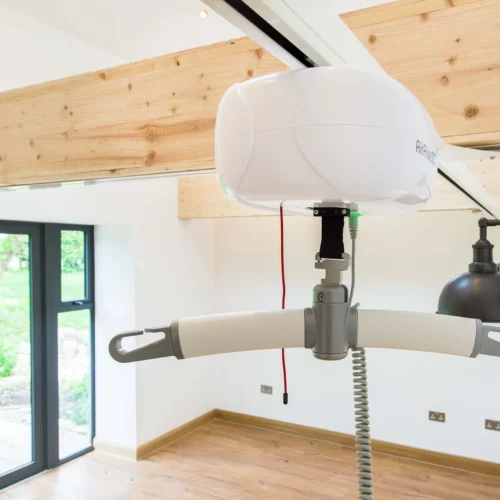Monorail vs X-Y Hoisting Systems: Which is best?
Posted on 17 August 2017 By Aaron Stretton

In This Article
If you’ve read Innova blogs before, you’ll know we often talk about monorails (also known as straight tracks) and X-Y hoist systems (sometimes referred to as H-frames) and the different layouts and fixings that can be used with each. We can even specify and install X-Y hoist systems that connect the straight tracks and vice versa. Both types of patient hoist systems have their pros and cons. But which is best, a monorail or a X-Y system?
Which Gives The Best Accessibility X-Y Hoist or Monorail?
One of the key things to think about when specifying a hoisting system is the level of accessibility needed in the environment. Straight tracks are a simple solution, and can be designed to pass over specific pick-up points in the room. For example, if you were installing a straight track in a bathroom, the hoist would need to be able to transfer to and from the toilet, bath/shower, and sink. A monorail layout can be designed to cater to these needs, providing straightforward transferring facilities.
However, if you’re looking for a more flexible accessibility, we suggest a X-Y hoist system. This can give the user coverage of the entire room, and is much more adaptable than a monorail track. The X-Y system consists of 2 parallel fixed rails installed at either side of the room, with a moving traverse rail hung between them. The hoist unit is then mounted on the traverse rail, giving it full range of the room.
Which is The Most Aesthetically Pleasing, X-Y Hoists or Monorail?
In terms of how the hoist looks, a X-Y system can be made subtler using our AirGlide360 inset tracking. This is something we offer to combat the problems of low ceilings, and low-hanging hoist systems that don’t necessarily blend in with the room. We use inset tracking on the 2 parallel fixed rails so that they are fitted flush to the ceiling, and therefore only the traverse rail is hung below the finished ceiling height.
On the other hand, a straight track can blend in a little easier than a X-Y system simply because it can all be inset to the ceiling. Again, we would use our AirGlide360 inset tracking to install the hoist system directly into the ceiling. This means that the only component of the overhead hoisting system that would be hanging from the ceiling is the hoist unit itself. We find that this option is particularly popular in hotels, where facilities need to be accessible without ruining the décor of the building.
Which Hoist System Costs More?
The cost of the hoisting system may also determine which layout you wish to go for. The price of an Ceiling Hoist System is determined on a case-by-case basis, and of course, it all depends on the size of the room and the various pick-up points that need to be included in the design.
Generally, we estimate that a monorail layout is about 30% cheaper than a X-Y system. This is because a X-Y system uses more parts and more track than a standard monorail layout. That being said, if you need a flexible hoisting system that can cater to a range of different users’ needs and abilities, then a X-Y hoist system is the best way to go.
Summary
It’s difficult to determine whether an X-Y hoist or Monorail hoisting system is the best one simply because it depends on what you’re looking for and what you need in terms of accessibility, aesthetics, and cost. It’s very clear in some cases that one supersedes the other one.
We recommend that you discuss your accessibility needs with a hoisting specialist first so that they can advise you on which configuration is best for your situation.
Related Products
Speak to The Experts
Need assistance with product enquiries, general inquiries, or product support? Our Phonelines are open 9am - 5pm Monday to Friday
0113 519 0319
Or, fill out the form for a call back.

